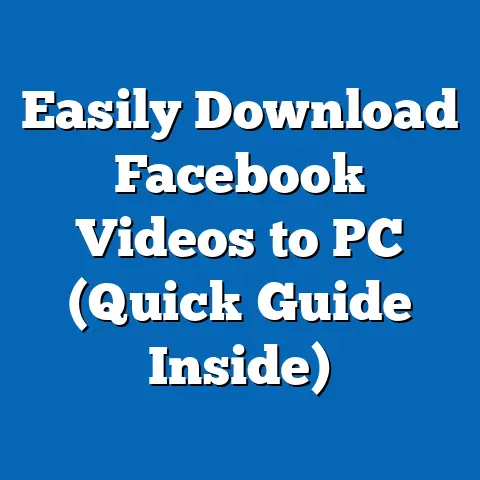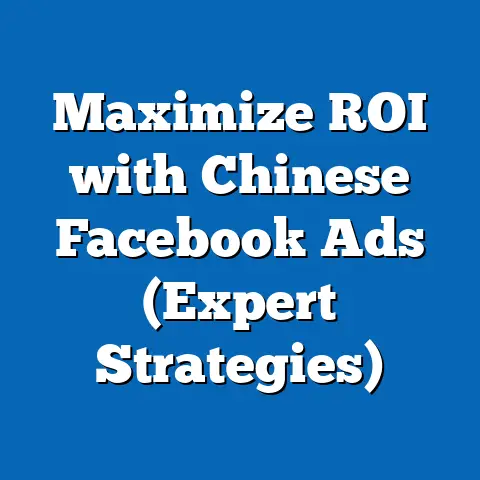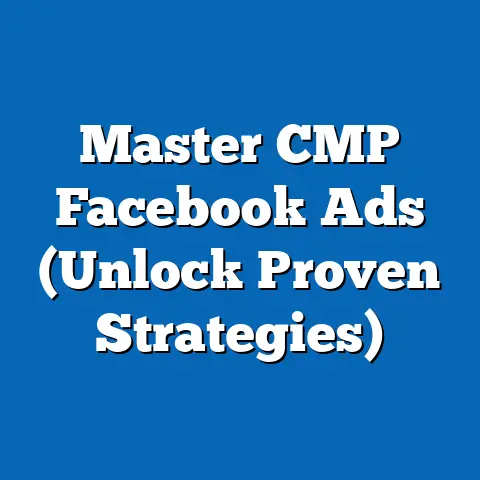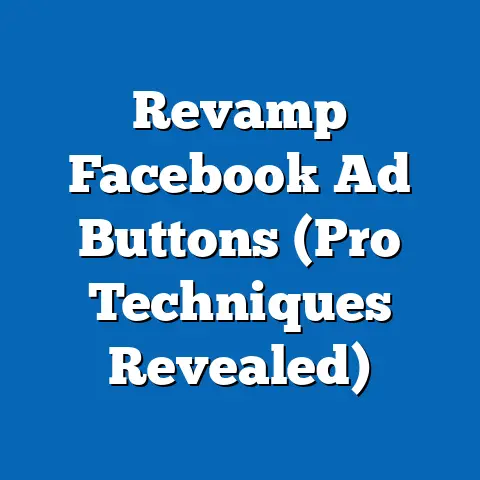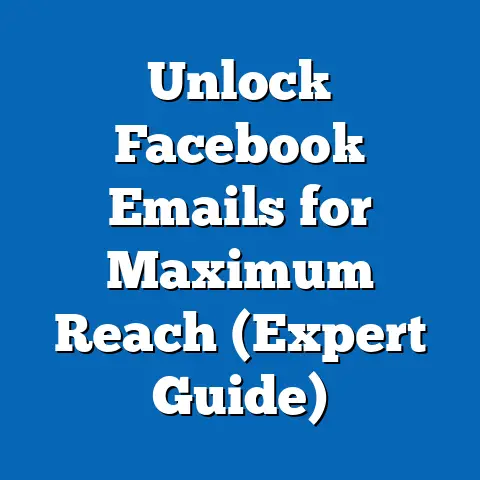Unleash GIF Ads on Facebook (Proven Strategies for Impact)
Hey there! Remember those early internet days when GIFs were all the rage? Simple animations that brought a smile to your face, shared endlessly on forums and early social media platforms. I do, and I’ve always had a soft spot for them. What started as a quirky way to express ourselves online has evolved into a powerful marketing tool. Today, in the fast-paced world of social media, GIFs can be the secret weapon to capture attention and create memorable Facebook ads that truly resonate with your audience.
I’ve seen firsthand how a well-placed GIF can transform a mundane ad into something engaging and shareable. In this guide, I’m going to walk you through the ins and outs of using GIFs in your Facebook ad campaigns. We’ll cover everything from understanding the power of GIFs to crafting compelling content, implementing proven strategies, and measuring your success. Get ready to unleash the full potential of GIF ads and take your Facebook marketing to the next level!
Understanding the Power of GIFs in Advertising
The Rise of Visual Content
Let’s face it: we live in a visual world. People are bombarded with information every second, and static images just don’t cut it anymore. The shift from static images to dynamic content is undeniable, and GIFs are leading the charge.
Did you know that ads with motion graphics or GIFs can have significantly higher engagement rates compared to traditional static ads? Studies have shown that using GIFs can increase click-through rates by as much as 20-30%. I’ve personally seen this in action. I once worked on a campaign for a local coffee shop. We A/B tested a static image of their latte against a GIF of the latte being poured, complete with swirling steam. The GIF outperformed the static image by a mile, resulting in a 25% increase in click-through rates and a noticeable boost in foot traffic to the shop.
This increase isn’t just anecdotal; it’s backed by data. Facebook’s own internal research indicates that visual content, especially moving images, significantly boosts ad performance. This is because our brains are wired to pay more attention to movement. It’s an evolutionary response – we’re naturally drawn to things that move, as it could signal danger or opportunity.
Key Takeaway: Embrace visual content, especially GIFs, to stand out in a crowded digital landscape and capture the attention of your target audience.
Emotional Connection
GIFs aren’t just about movement; they’re about emotion. They have the power to evoke feelings and connect with audiences on a personal level in a way that static visuals often can’t. Think about it: a simple “laughing” GIF can convey a sense of humor and relatability that a written joke might miss.
I remember working on a campaign for a mental health organization. We were trying to raise awareness about stress management. Instead of using a generic image of someone looking stressed, we created a series of GIFs showing simple relaxation techniques, like deep breathing and stretching. These GIFs were lighthearted and relatable, and they resonated deeply with our audience. We saw a significant increase in shares and comments, with many people expressing how much they appreciated the simple, actionable advice presented in a fun, engaging format.
GIFs can also be incredibly effective in storytelling. They can quickly convey a narrative or a message, making them perfect for capturing attention in a fast-scrolling newsfeed. By using GIFs, you can showcase your brand’s personality, values, and even its sense of humor. This helps create a deeper connection with your audience, making them more likely to remember your brand and engage with your content.
Key Takeaway: Use GIFs to tap into emotions, tell compelling stories, and create a deeper connection with your audience.
Shareability Factor
One of the biggest advantages of GIFs is their shareability. On social media platforms like Facebook, GIFs are incredibly easy to share, which can amplify your brand’s reach and engagement exponentially.
Think about the last time you saw a GIF that made you laugh or think. What did you do? You probably shared it with your friends or family. This is the power of GIFs. They’re inherently shareable because they’re entertaining, relatable, and often express emotions that people want to share with others.
I’ve seen campaigns go viral simply because they used a clever GIF that resonated with a large audience. I once helped a local bakery promote their new line of cupcakes. We created a GIF of a cupcake being decorated with frosting and sprinkles. It was simple, but incredibly appealing. The GIF was shared thousands of times, and the bakery saw a huge surge in orders.
The shareability of GIFs can also lead to organic reach, which means more people seeing your content without you having to pay for it. When people share your GIF, their friends and followers see it, and if they find it interesting, they’re likely to share it too. This creates a ripple effect that can significantly expand your brand’s visibility.
Key Takeaway: Create GIFs that are entertaining, relatable, and easy to share to amplify your brand’s reach and engagement on Facebook.
Crafting Compelling GIF Ads
Know Your Audience
Before you start creating GIF ads, it’s crucial to understand your target audience. What are their preferences? What kind of humor do they appreciate? What are their pain points and aspirations? Knowing your audience is the foundation of any successful marketing campaign, and it’s especially important when it comes to GIFs.
Demographic factors can significantly influence the design and content of your GIF ads. For example, if you’re targeting a younger audience, you might use GIFs that are trendy and meme-inspired. On the other hand, if you’re targeting an older audience, you might opt for GIFs that are more classic and timeless.
I remember working on a campaign for a financial services company. We initially created GIFs that were humorous and lighthearted, thinking that would appeal to everyone. However, we quickly realized that our target audience, which consisted of older, more conservative individuals, didn’t appreciate the humor. We had to pivot and create GIFs that were more professional and informative, focusing on the benefits of their services.
Understanding your audience also means knowing what platforms they use and what kind of content they engage with on those platforms. For example, GIFs that work well on TikTok might not work as well on Facebook. You need to tailor your GIFs to the specific platform and audience you’re targeting.
Key Takeaway: Invest time in understanding your target audience’s preferences, behaviors, and demographics to create GIF ads that resonate with them.
Creating Engaging Content
Creating engaging GIF content is both an art and a science. It requires creativity, attention to detail, and a deep understanding of what makes a GIF visually appealing and relevant.
First and foremost, your GIFs should be visually appealing. This means using high-quality images or videos, choosing colors that are eye-catching, and ensuring that the animation is smooth and seamless. No one wants to watch a GIF that’s blurry or choppy.
Your GIFs should also be relevant to your brand messaging. They should communicate your brand’s values, personality, and unique selling proposition. Don’t just create a GIF for the sake of creating a GIF. Make sure it aligns with your overall marketing goals and objectives.
I’ve seen firsthand how a well-crafted GIF can turn a boring product into something exciting and desirable. I once worked with a clothing retailer that was struggling to promote their new line of jeans. We created a GIF of someone trying on the jeans and doing a little dance. The GIF was fun, energetic, and showed off the jeans in a way that a static image couldn’t. The result? A significant increase in sales and a lot of positive feedback from customers.
Key Takeaway: Create GIFs that are visually appealing, relevant to your brand messaging, and aligned with your overall marketing goals.
Length and Timing
When it comes to GIF ads on Facebook, less is often more. The ideal length for a GIF is short and impactful. You want to capture viewers’ attention without overwhelming them.
I generally recommend keeping your GIFs under 5-10 seconds. This is enough time to convey your message without losing viewers’ interest. Remember, people are scrolling through their newsfeeds quickly, so you need to make an impression in a short amount of time.
The timing of your animations is also crucial. You want to make sure that the animation is smooth and seamless, and that the key elements of your message are highlighted at the right moments. Avoid animations that are too fast or too slow. You want to find a pace that’s engaging and easy to follow.
I once worked on a campaign for a restaurant that was promoting their lunch specials. We created a GIF of a sandwich being assembled, with each ingredient being added one by one. The GIF was visually appealing, but the animation was too slow. By the time the sandwich was finished, viewers had already lost interest. We sped up the animation, and the GIF became much more effective.
Key Takeaway: Keep your GIFs short and impactful, with a smooth and engaging animation that highlights the key elements of your message.
Proven Strategies for Effective GIF Ads on Facebook
A/B Testing for Optimization
A/B testing is essential for optimizing your GIF ads and ensuring that you’re getting the best possible results. It involves creating two or more versions of your ad and testing them against each other to see which one performs better.
I always recommend A/B testing different elements of your GIF ads, such as the visuals, the messaging, and the call-to-action. This will help you identify what resonates most with your audience and make informed decisions about your ad campaigns.
I remember working on a campaign for a software company. We created two versions of a GIF ad: one that focused on the features of the software and one that focused on the benefits. We A/B tested the two versions and found that the one that focused on the benefits performed much better. This taught us that our audience was more interested in how the software could help them solve their problems than in the technical details.
To conduct A/B tests effectively, make sure to change only one element at a time. This will allow you to isolate the impact of that element on the ad’s performance. Also, make sure to run your tests for a sufficient amount of time to gather enough data to make meaningful conclusions.
Key Takeaway: A/B test different elements of your GIF ads to identify what resonates most with your audience and make informed decisions about your ad campaigns.
Integrating GIFs with Facebook’s Ad Formats
Facebook offers a variety of ad formats that you can use to integrate GIFs, including single image ads, carousel ads, and stories. Each format has its own advantages and disadvantages, so it’s important to choose the one that best suits your goals and objectives.
Single image ads are the simplest and most straightforward format. They consist of a single GIF and some accompanying text. This format is great for conveying a simple message quickly and effectively.
Carousel ads allow you to showcase multiple GIFs in a single ad. This format is great for telling a story or showcasing a range of products or services. I’ve seen carousel ads used effectively to highlight different features of a product or to show a step-by-step process.
Stories are a more immersive and engaging format. They allow you to create a series of short, visually appealing GIFs that capture viewers’ attention. Stories are great for showcasing your brand’s personality and creating a deeper connection with your audience.
Key Takeaway: Experiment with different Facebook ad formats to find the one that best suits your goals and objectives and allows you to integrate GIFs effectively.
Call-to-Action (CTA)
A strong call-to-action (CTA) is essential for driving conversions with your GIF ads. Your CTA should tell viewers what you want them to do after seeing your ad, whether it’s to visit your website, make a purchase, or sign up for your newsletter.
Your CTA should be clear, concise, and action-oriented. Use verbs like “Shop Now,” “Learn More,” or “Sign Up” to encourage viewers to take action. Also, make sure your CTA is visually prominent and easy to see. Use a button or a bold font to make it stand out.
I remember working on a campaign for an e-commerce store. We created a GIF ad showcasing their new line of shoes. The ad was visually appealing, but it didn’t have a strong CTA. As a result, the ad didn’t generate many sales. We added a “Shop Now” button to the ad, and the sales increased significantly.
Your CTA should also be relevant to your audience and your offer. For example, if you’re offering a discount, your CTA might be “Get 20% Off.” If you’re promoting a new product, your CTA might be “Discover Now.”
Key Takeaway: Incorporate a strong, clear, and action-oriented CTA in your GIF ads to drive conversions and achieve your marketing goals.
Measuring Success and Analytics
Key Performance Indicators (KPIs)
To track the performance of your GIF ads on Facebook, you need to identify the essential Key Performance Indicators (KPIs) that will help you measure your success. Some of the most important KPIs include engagement rates, click-through rates, and conversion rates.
Engagement rates measure how people are interacting with your ad. This includes likes, comments, shares, and saves. A high engagement rate indicates that your ad is resonating with your audience and capturing their attention.
Click-through rates (CTR) measure the percentage of people who see your ad and click on it. A high CTR indicates that your ad is relevant and compelling to your audience.
Conversion rates measure the percentage of people who click on your ad and then take a desired action, such as making a purchase or signing up for your newsletter. A high conversion rate indicates that your ad is effectively driving results and achieving your marketing goals.
Key Takeaway: Identify the essential KPIs to track the performance of your GIF ads and measure your success.
Tools for Analysis
Facebook Ads Manager is the primary tool for managing and analyzing your Facebook ad campaigns. It provides detailed data on your ad’s performance, including engagement rates, click-through rates, and conversion rates.
Google Analytics is a powerful tool for tracking website traffic and user behavior. You can use it to see how people are interacting with your website after clicking on your GIF ads.
Third-party analytics tools, such as Hootsuite and Sprout Social, can provide additional insights into your ad’s performance and help you track your social media metrics.
Key Takeaway: Use a variety of tools and platforms to analyze the performance of your GIF ads and gain insights into audience behavior and ad effectiveness.
Learning from Data
The data you collect from your analytics tools is invaluable for refining and improving your future GIF ad campaigns. By analyzing your data, you can identify what’s working and what’s not, and make informed decisions about your ad strategy.
For example, if you see that your engagement rates are low, you might need to rethink your visuals or your messaging. If you see that your click-through rates are low, you might need to improve your targeting or your call-to-action. If you see that your conversion rates are low, you might need to optimize your landing page or your offer.
I always tell my clients to treat their ad campaigns as experiments. Don’t be afraid to try new things and see what works. The data will guide you, and over time, you’ll become more effective at creating GIF ads that drive results.
Key Takeaway: Leverage data and analytics to refine and improve your future GIF ad campaigns based on past performance.
Case Studies of Successful GIF Advertising Campaigns
Brand Success Stories
To illustrate the power of GIF ads on Facebook, let’s take a look at some case studies of brands that have successfully utilized this medium.
Netflix: Netflix is a master of using GIFs to promote their shows and movies. They often create GIFs that highlight funny or dramatic moments from their content, which are then shared widely on social media.
Old Spice: Old Spice is known for their humorous and over-the-top advertising campaigns. They often use GIFs to showcase their brand’s personality and create engaging content that goes viral.
Domino’s: Domino’s has used GIFs to promote their pizza and other menu items. They often create GIFs that show the pizza being made or being enjoyed by customers.
Lessons Learned
From these case studies, we can extract some key lessons that you can apply to your own GIF ad campaigns.
First, make sure your GIFs are relevant to your brand and your audience. Don’t just create a GIF for the sake of creating a GIF. Make sure it aligns with your overall marketing goals and objectives.
Second, make sure your GIFs are visually appealing and engaging. Use high-quality images or videos, choose colors that are eye-catching, and ensure that the animation is smooth and seamless.
Third, incorporate a strong call-to-action in your GIF ads. Tell viewers what you want them to do after seeing your ad, whether it’s to visit your website, make a purchase, or sign up for your newsletter.
Conclusion: Embracing the Future of Advertising with GIFs
GIFs are more than just quirky animations from the early days of the internet. They’re a powerful tool for capturing attention, evoking emotions, and driving engagement in today’s fast-paced social media landscape. I firmly believe that they represent a transformative opportunity for Facebook advertising.
By understanding the power of GIFs, crafting compelling content, implementing proven strategies, and measuring your success, you can unleash the full potential of GIF ads and take your Facebook marketing to the next level.
So, what are you waiting for? Start experimenting with GIF ads in your next Facebook campaign and see the results for yourself. Remember, creativity, relevance, and emotional connection are key to driving impactful engagement. Go forth and create some GIF magic!

